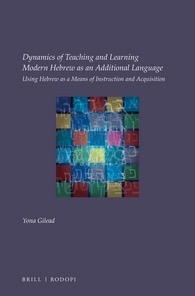teaching Hebrew
Select an item by clicking its checkbox

Dynamics of Teaching and Learning Modern Hebrew as an Additional Language: Using Hebrew as a Means of Instruction and Acquisition
Date Reviewed: November 2, 2018
This book examines the use of Hebrew as the primary means of instruction for second or additional language (L2) acquisition at an introductory level in academic contexts where English is the native language. The author, Yona Gilead, seeks to address the relative dearth of theorization on the dynamics of using Hebrew as the primary language for THAL (teaching Hebrew as an additional language) in order to begin to situate it within a larger framework of L2 teaching, learning, and research. Dynamics of Teaching and Learning Modern Hebrew as an Additional Language provides a presentation and analysis of the pedagogy promulgated by the Hebrew University’s Rothberg International School (RIS) adapted for use at an Australian university. In looking at the implementation of the RIS method outside of Israel the book focuses on the adaptability of the Hebrew-in-Hebrew approach for localized use.
In contradistinction to teaching Hebrew from a heritage language perspective, where grammar and literacy are emphasized and the ability to read and analyze culturally important texts such as the Bible, Mishnah, and Talmud are the primary goals of instruction, the RIS method that Gilead evaluates focuses on spoken, workaday Hebrew where the goals are comprehension of aurally received data and generation of intelligible responses. The latter approach, referred to in some broader L2 discussions as the Direct Method, dispenses with grammar altogether, prompting students to learn grammar inductively as a natural consequence of language acquisition. Gilead provides a brief historical background of the RIS method, situating it in its current context amid a larger L2 field, and discusses what is achievable using the RIS method at the introductory level outside of Israel. The major modification of this method for the Australian classroom is the teacher’s prerogative to break, fleetingly, from Hebrew in order to provide a concise grammatical explanation. Certainly Gilead’s analysis, which includes interviews with the participants (students and teacher, independently), shows that the students found that the addition of this allowance was a boon to their understanding; many of the students she interviewed comment that that it was essential to have these breaks for grammar.
Gilead is quite positive about the effectiveness of the technique but does not go into great detail to this end. There is definitely room for discussion, perhaps in a future publication, of how students perform in more advanced levels of instruction. Do students approach literacy while in formal classroom contexts? How does this method serve its students when they are no longer in a structured environment? Does the method prepare them to be life-long learners? Are students able to navigate resources that will allow them to continue learning, especially if they are not in an immersive environment once the class ends?
Overall, the book’s methodology, which includes dialogue, interview, and case study is clear and implemented well. This study raises important pedagogical issues for university Hebrew programs reassessing their curriculum goals and needs. Gilead makes a solid contribution in identifying and theorizing key aspects of THAL classroom dynamics.